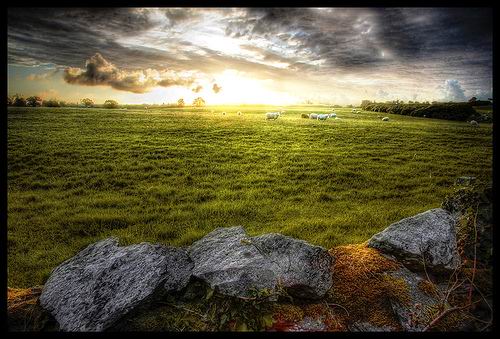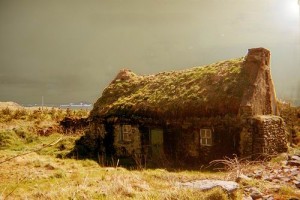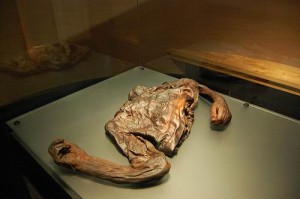 A little over two weeks ago, on the evening of August 10th, a young Irish heavy-equipment operator spotted what he thought was an old leather car seat jutting out of the drained fields of Cashel Bog. Jason Phelan was nearing the end of a long day on a harvester, a giant machine that slices peat from drained bogs and rakes it into piles for garden compost. But Phelan knew that Ireland’s bogs occasionally cede strange treasure. So he hopped down from the cab to take a closer look.
A little over two weeks ago, on the evening of August 10th, a young Irish heavy-equipment operator spotted what he thought was an old leather car seat jutting out of the drained fields of Cashel Bog. Jason Phelan was nearing the end of a long day on a harvester, a giant machine that slices peat from drained bogs and rakes it into piles for garden compost. But Phelan knew that Ireland’s bogs occasionally cede strange treasure. So he hopped down from the cab to take a closer look.
The object, half-buried in the turf, was chestnut-brown. It looked like old leather, a piece of something–something, on closer inspection, that was definitely not a car seat. Phelan puzzled over it, considering the possibilities. Then he took hold of it and gave it a tug. A pair of ancient, twisted human legs slipped loose from the turf.
 Ireland was once a land of shadowy forests and dappled green light. That was until some of the world’s greatest seafarers came calling, first the Vikings, then the British Navy, and stripped Irish woodlands for the heartwood planks they needed to build ships. By the 1600s, Ireland’s great oak forests were mere memories to most of its inhabitants. Irish peasants had little choice but to heat their homes with a humbler fuel. Peat. So each year, in spring or early summer, men set out to the bogs to cut supplies. And sometimes, when they were least expecting it, they pulled up marvels from the bottom–gold bracelets, bronze cauldrons, and parts of human bodies, nearly 100 bodies in all. The chemistry of the bog waters eerily preserved these cadavers. Some dated back 2000 to 3000 years.
Ireland was once a land of shadowy forests and dappled green light. That was until some of the world’s greatest seafarers came calling, first the Vikings, then the British Navy, and stripped Irish woodlands for the heartwood planks they needed to build ships. By the 1600s, Ireland’s great oak forests were mere memories to most of its inhabitants. Irish peasants had little choice but to heat their homes with a humbler fuel. Peat. So each year, in spring or early summer, men set out to the bogs to cut supplies. And sometimes, when they were least expecting it, they pulled up marvels from the bottom–gold bracelets, bronze cauldrons, and parts of human bodies, nearly 100 bodies in all. The chemistry of the bog waters eerily preserved these cadavers. Some dated back 2000 to 3000 years.
Jason Phelan was pretty sure that’s what he’d found, a bog body. He reported it to a supervisor, and the next day, Eamonn Kelly, the keeper of Irish antiquities at the National Museum of Ireland, drove out from Dublin to examine the discovery.
Turf-cutters had recovered a host of ritual offerings from Cashel Bog over the decades–leather shoes, lumps of bog butter, even a Bronze-Age axe. Kelly strongly suspected that the headless corpse was yet another such offering. Some 2000 years ago, many northern European tribes revered bogs as watery lands steeped in magic and power, portals to the otherworld. The bogs lying along tribal boundaries seemed to possess the strongest magic of all and so required the greatest sacrifices: human lives. Irish archaeologists had recovered six well-dated bog bodies from the wetlands along tribal boundaries: nearly three dozen other bog bodies appeared to come from similar boundary regions. The new discovery, Kelly explained to a reporter from the Leinster Express, fit this pattern. Cashel bog lay, he said, along an old “tribal border between the kingdoms of Laoighis and Ui Buide.”
 Ireland’s Celts seem to have been fussy about whom they sacrificed in these places. They favored very important, powerful men. Clonycavan Man, noted Kelly in a paper in Sceal na Mona, went to his watery grave wearing an expensive imported hair gel on his splendid mohawk-like haircut. And Oldcroghan Man’s uncalloused hands looked as if they had never seen a day of work. His fingernails were beautifully manicured–hardly the norm in Iron-Age Europe.
Ireland’s Celts seem to have been fussy about whom they sacrificed in these places. They favored very important, powerful men. Clonycavan Man, noted Kelly in a paper in Sceal na Mona, went to his watery grave wearing an expensive imported hair gel on his splendid mohawk-like haircut. And Oldcroghan Man’s uncalloused hands looked as if they had never seen a day of work. His fingernails were beautifully manicured–hardly the norm in Iron-Age Europe.
But the most revealing clues to their identities came from a careful examination of wounds they received near their time of death. Someone had pinched and cut the nipples of both Clonycavan Man and Oldcroghan Man. This wasn’t some kind of failed piercing though: it was mutilation with a purpose. Strange as it sounds to us today, the high nobles in Celtic Ireland demonstrated their submission to a king by ceremonially suckling at his nipples. A king without nipples was clearly no king at all, and the ancient Irish lacked sentimentality when it came to their monarchs. According to early Irish histories, the people of Tara sometimes sacrificed their great kings during an autumn festival known as Samhain. By doing so, they believed they could bring new life and vigor to the land.
Perhaps, just perhaps, some of Ireland’s bog bodies were deposed rulers. And perhaps the old leather car seat that Jason Phelan thought he saw near the end of his shift was really the last remains of a legendary king. Kelly and his team are now scrutinizing the body carefully.
We think we are far, far beyond the mythical past of Irish bards and poets. And yet sometimes, when we least expect it, a watery portal suddenly opens and we step into another world.
Photos: Upper,Untitled, courtesy Sergey vyaltsev. Middle: Prime Real Estate. Courtesy The Lizard Queen; Bottom: Oldcroghan Man. Courtesy, Whtthfckkkkk.
Great article, Heather. Well written and informative. My only complaint is I was wondering why you use a dash instead of an Em dash in your sentences when you are explaining things further or using asides? I kept thinking that the words with a regular dash between them were one word instead of an aside and it made the reading confusing. Just a suggestion.
Thanks,
Kirsten